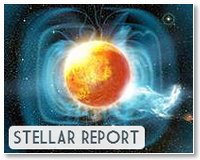 |
Paris, France (SPX) Mar 17, 2011 A new image from ESO's Very Large Telescope gives a close-up view of the dramatic effects newborn stars have on the gas and dust from which they formed. Although the stars themselves are not visible, material they have ejected is colliding with the surrounding gas and dust clouds and creating a surreal landscape of glowing arcs, blobs and streaks. The star-forming region NGC 6729 is part of one of the closest stellar nurseries to the Earth and hence one of the best studied. This new image from ESO's Very Large Telescope gives a close-up view of a section of this strange and fascinating region (a wide-field view is available here). The data were selected from the ESO archive by Sergey Stepanenko as part of the Hidden Treasures competition. Sergey's picture of NGC 6729 was ranked third in the competition. Stars form deep within molecular clouds, and the earliest stages of their development cannot be seen in visible-light telescopes because of obscuration by dust. In this image there are very young stars at the upper left of the picture. Although they cannot be seen directly, the havoc that they have wreaked on their surroundings dominates the picture. High-speed jets of material that travel away from the baby stars at velocities as high as one million kilometers per hour are slamming into the surrounding gas and creating shock waves. These shocks cause the gas to shine and create the strangely colored glowing arcs and blobs known as Herbig-Haro objects. In this view the Herbig-Haro objects form two lines marking out the probable directions of ejected material. One stretches from the upper left to the lower center, ending in the bright, circular group of glowing blobs and arcs at the lower center. The other starts near the left upper edge of the picture and extends towards the center right. The peculiar scimitar-shaped bright feature at the upper left is probably mostly due to starlight being reflected from dust and is not a Herbig-Haro object. This enhanced-color picture was created from images taken using the FORS1 instrument on ESO's Very Large Telescope. Images were taken through two different filters that isolate the light coming from glowing hydrogen (shown as orange) and glowing ionized sulphur (shown as blue). The different colors in different parts of this violent star formation region reflect different conditions - for example where ionized sulphur is glowing brightly (blue features) the velocities of the colliding material are relatively low - and help astronomers to unravel what is going on in this dramatic scene.
Share This Article With Planet Earth
Related Links ESO Stellar Chemistry, The Universe And All Within It
 Astronomers detect 'room temperature' star
Astronomers detect 'room temperature' starUniversity Park, Pa. (UPI) Mar 14, 2011 U.S. astronomers have discovered a brown dwarf star that contradicts the perception of all stars being hot - this one is, in fact, room temperature, they say. Like normal stars, brown dwarfs form from collapsing gas clouds, but they don't become massive enough to sustain nuclear reactions, so they briefly shine red from the heat of formation then fade. Still, before discovering ... read more |
|
| The content herein, unless otherwise known to be public domain, are Copyright 1995-2010 - SpaceDaily. AFP and UPI Wire Stories are copyright Agence France-Presse and United Press International. ESA Portal Reports are copyright European Space Agency. All NASA sourced material is public domain. Additional copyrights may apply in whole or part to other bona fide parties. Advertising does not imply endorsement,agreement or approval of any opinions, statements or information provided by SpaceDaily on any Web page published or hosted by SpaceDaily. Privacy Statement |